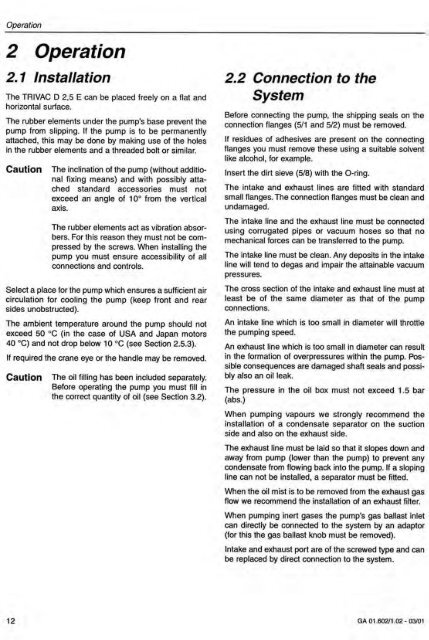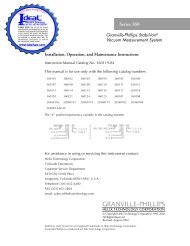Leybold D 2,5 E, D 2.5 E - Ideal Vacuum Products, LLC
Leybold D 2,5 E, D 2.5 E - Ideal Vacuum Products, LLC
Leybold D 2,5 E, D 2.5 E - Ideal Vacuum Products, LLC
Create successful ePaper yourself
Turn your PDF publications into a flip-book with our unique Google optimized e-Paper software.
Operation<br />
2 Operation<br />
2.1 Installation<br />
The TRIVAC 0 2,5 E can be placed freely on a flat and<br />
horizontal surface.<br />
The rubber elements under the pump's base prevent the<br />
pump from slipping. If the pump is to be permanently<br />
attached, this may be done by making use of the holes<br />
in the rubber elements and a threaded bolt or similar.<br />
Caution The inclination of the pump (without additional<br />
fixing means) and with possibly attached<br />
standard accessories must not<br />
exceed an angle of 10° from the vertical<br />
axis.<br />
The rubber elements act as vibration absorbers.<br />
For this reason they must not be compressed<br />
by the screws. When installing the<br />
pump you must ensure accessibility of all<br />
connections and controls.<br />
Select a place for the pump which ensures a sufficient air<br />
circulation for cooling the pump (keep front and rear<br />
sides unobstructed).<br />
The ambient temperature around the pump should not<br />
exceed 50 °C (in the case of USA and Japan motors<br />
40 0c) and not drop below 10 °C (see Section <strong>2.5</strong>.3).<br />
If required the crane eye or the handle may be removed.<br />
Caution The oil filting has been included separately.<br />
Before operating the pump you must fill in<br />
the correct quantity of oil (see Section 3.2).<br />
12<br />
2.2 Connection to the<br />
System<br />
Before connecting the pump, the shipping seals on the<br />
connection flanges (511 and 512) must be removed.<br />
If residues of adhesives are present on the connecting<br />
flanges you must remove these using a suitable solvent<br />
like alcohol, for example.<br />
Insert the dirt sieve (518) with the O-ring.<br />
The intake and exhaust lines are filted with standard<br />
small flanges. The connection flanges must be clean and<br />
undamaged.<br />
The intake line and the exhaust line must be connected<br />
using corrugated pipes or vacuum hoses so that no<br />
mechanical forces can be transferred to the pump.<br />
The intake line must be clean. Any deposits in the intake<br />
line will tend to degas and impair the attainable vacuum<br />
pressures.<br />
The cross section of the intake and exhaust line must at<br />
least be of the same diameter as that of the pump<br />
connections.<br />
An intake line which is too small in diameter will throttle<br />
the pumping speed.<br />
An exhaust line which is too small in diameter can result<br />
in the formation of overpressures within the pump. Possible<br />
consequences are damaged shaft seals and possibly<br />
also an oil leak.<br />
The pressure in the oil box must not exceed 1.5 bar<br />
(abs.)<br />
When pumping vapours we strongly recommend the<br />
installation of a condensate separator on the suction<br />
side and also on the exhaust side.<br />
The exhaust line must be laid so that it slopes down and<br />
away from pump (lower than the pump) to prevent any<br />
condensate from flowing back into the pump. If a sloping<br />
line can not be installed, a separator must be fitted.<br />
When the oil mist is to be removed from the exhaust gas<br />
flow we recommend the installation of an exhaust filter.<br />
When pumping inert gases the pump's gas ballast inlet<br />
can directly be connected to the system by an adaptor<br />
(for this the gas ballast knob must be removed).<br />
Intake and exhaust port are of the screwed type and can<br />
be replaced by direct connection to the system.<br />
GA 01 .60211 .02 - 00101

















